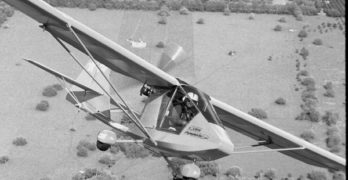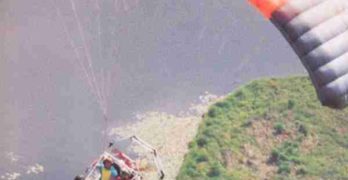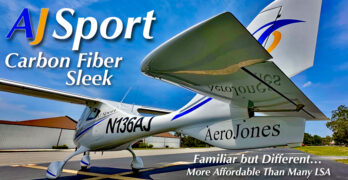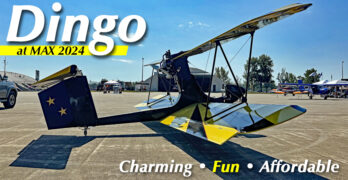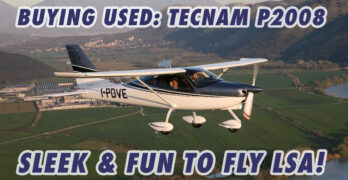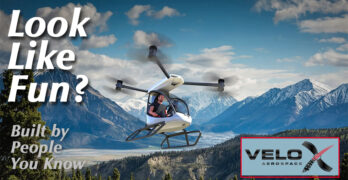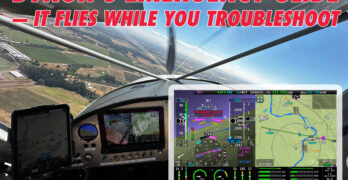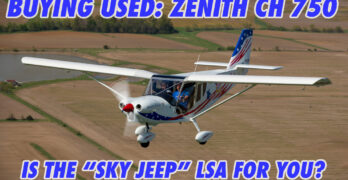One of the ultralight industry’s longest enduring designs is the Hawk. First offered in 1982, the Hawk flies today – 15 years later! – in essentially the same form. A few years ago the Arrow name was added to a refined version (becoming the Hawk Arrow) but the basics didn’t change. The original became the Hawk Classic.
So, why are we reporting on it? Two reasons quickly spring to mind.
First, the plane deserves it. This is an excellent little bird that has delivered a lot of aerial fun to virtually a generation of pilots. However, new pilots enter the community between articles and these aviators need to know this design still works well today like it did way back in the early ’80s when ultralights were new on the aviation scene.
Secondly, this isn’t the same Hawk.
Oh, it still looks much the same. Such a statement is hardly fair, though, to the many refinements that showed up on the plane I flew for this report.
Search Results for : CT AND hand control
Not finding exactly what you expected? Try our advanced search option.
Select a manufacturer to go straight to all our content about that manufacturer.
Select an aircraft model to go straight to all our content about that model.
St. Andrews Aviation — Viking II
St. Andrews Aviation boss Charles Dozier calls his new Viking II a “parachute plane” rather than simply a powered parachute. In one particular way it certainly isn’t like those which preceded the new aircraft: Viking II employs side-by-side seating in the first such example with which I’m aware among powered parachute aircraft. For those doing training in these machines, such side seating is usually considered optimal so the instructor can better interact with his student.
Ground steering is also made intuitive by employing a steering bar that works the way a bicycle does (whereas many powered parachutes use a joystick-type control for ground handling). Because the seats are alongside one another, Dozier was also able to centralize the throttle and nosewheel brake. Another benefit, says the designer, is a lowered center of gravity because the student or other occupant is not raised above and behind as in most powered parachutes.
For in-air steering – which requires the use of your feet on powered parachutes – the Viking II has a dual set of foot pedals such that either occupant can fly the machine while the other observes.
New “Made-in-USA” Aircraft — Welcome AJ Sport to the LSA Fleet
Is it because of tariffs? Another reason? Or simply a good idea? Does it matter why you’re reading about AJ Sport?
U.S. government policies swing and sway the world in remarkable ways. That’s a whole story in itself, but the way aircraft suppliers respond to the situation they are facing can be instructive.
To be clear, AeroJones Aviation is not reacting to tariff changes. This company, headquartered in U.S.-friendly Taiwan, has been working toward entering the American market for years. For more than a decade, AeroJones has been the officially-licensed producer of Flight Design’s CTLS and CTLSi for Asia-Pacific. They don’t simply import and sell units built in Europe. They do 100% of the fabrication, assembly, and production test flights in the Asian theater. They’ve delivered more than 50 aircraft and have won multiple CAAC airworthiness approvals.
A video to follow soon features SilverLight Aviation‘s Abid Farooqui describing several notable changes the company achieved.
Bingo! It’s Dingo… A Charming, Fun, Affordable Part 103 Ultralight Biplane
If you look at Dingo and smile, you may be an ultralighter. Appearance and qualities about Future Vehicles‘ single seat bi-wing flying machine attract certain pilots like bees to a bright flower.
If you must have two seats, large flat screen displays, an autopilot, and luxurious appointments, you probably are not attracted to Dingo. Fine. The good news is that you’ll have plenty of choices among Mosaic LSA.
Those of us still smiling at the nearby images might already be captivated. If you are caught by Dingo’s interesting specs and its affordability, you might want to learn more. So, here’s more…
Dingo Is for Fun
Shown to Americans for the first time at MAX 2024 (Midwest Aviation Expo) by Bluff City Aircraft, Dingo drew steady interest from the fun flying crowd. For a grin-producing flight at the end of your workday, Dingo might be just about perfect.
Changing LSA Seaplane Market — Vickers Wave Progress Update — Others, Hmmm…?
Winter is coming, so naturally, it’s time to start thinking about seaplanes… right? It always seems weird to write about water-based activities as frost begins to envelop the northern two-thirds of the country. Yet winter is when all the big boat shows happen because buying new vessels requires advance planning. It’s also pleasant to think about spring and summer while snow flurries fly.
For many years I’ve written about this sector and names like Searey, Seamax, and Aventura (all in nearby image) have long been the leading brands. Now the first two are in financial trouble and the last has decamped to Brazil from Florida. Whatever is going on, Vickers Wave may represent a breath of fresh air.
In articles last fall and this spring, I gave overviews of the entire LSA seaplane market (read here or here).
Vickers Wave Update
Vickers previously noted, “Wave has finished its flight testing, resulting in a 120-knot cruise and useful load of 750 pounds powered by a Rotax 916iS (reviewed here).”
“A frequently asked question I receive is, ‘What is taking so long?’,” begins Paul Vickers.
Higher Flyer: The WT9 Dynamic Turbo
Lined up on the runway, I open the throttle to the stop. The Dynamic surges forward, my right thumb presses a small button at the base of the throttle quadrant and I push the lever further forward. In an instant there’s 15% more thrust and the speed tape really starts to roll. Ease back on the stick and we’re airborne after a very short ground roll and climbing away at well over 1200 fpm.
Flaps up, and 20 seconds later we’re passing through 400 feet, I pull the power back past the detent and the turbocharger control unit (TCU) reduces boost to 35 inches of manifold pressure. I then lower the nose, dial the prop rpm down to 5500 engine rpm and note the VSI is still showing around 1000 fpm before swinging the shapely spinner onto a south-easterly heading. Already I can see that the field of view is phenomenal and feel that the handling is crisp and taut.
Buying Used: Tecnam P2008
Most of the factory-built Light Sport aircraft that rolled after the FAA defined the category in 2004 were rather utilitarian—with rudimentary avionics and spartan interiors. Some of today’s Light Sport planes, however, are better equipped and more luxurious inside than GA planes that cost significantly more. Tecnam Aircraft was among the first manufacturers to recognize there was a market for upscale LSAs, and it responded with the P2008. The plane has become one of the company’s most popular aircraft.
“I don’t think there’s a better value out there when you look at ownership costs and resale price,” contends Mark Gregor, a former Tecnam dealer and long-time P2008 owner. “I don’t consider it an LSA…just a top choice for a two-seat aircraft.”
If buying a used P2008 is something you’re contemplating, then this article is for you. It will introduce you to the aircraft, model variations and flight characteristics, as well as provide advice for a pre-buy inspection and long-term ownership.
A Multicopter Current Pilots Might Enjoy? …Developed Within Our LSA Industry
Here’s a helicopter-like aircraft you might actually consider. I have often reviewed what I call multicopters (several articles). I searched for aircraft you might fly for fun; several of them can enjoy the freedom and special benefits of Part 103. I’ve stayed away from commercial “air taxi” projects.
But what if a longtime producer of Light-Sport Aircraft entered the space? What if the aircraft looked like a helicopter but one you could fly without the steep learning curve? What if it offered 45 minutes of flight with a 15-minute reserve?
The earliest entries had short flight times, 15-20 minutes. Most of them cost too much. For example, Opener’s Blackfly (now called Helix) was first promoted at the cost of a “luxury SUV,” perhaps meaning $80,000 at the time. It has since more than doubled in price.
You may doubt or dislike these flying machines, especially when you don’t know the people behind the projects.
Flying Dynon’s Emergency Glide Feature — Go Down Easy (UPDATED)
I probably shouldn’t admit this, but some features that come with the latest electronic flight instruments have left me a little, um, disinterested. Until I try them, that is. A good example is the concept of “safe glide” or even autoland. Garmin introduced both concepts a few years ago, though the full-autoland idea is more recent and limited to high-end aircraft where the system can control the engine directly. That’s not at my pay grade.
The more common version is what Garmin calls Smart Glide and, more recently, Dynon rolled out what it calls Emergency Glide. They work similarly: When commanded, they set up a controlled descent to the nearest viable airport and let the pilot concentrate on other things. To be honest, I was a bit meh about them as safety features. After all, you’re trained to set the airplane up for best-glide speed as soon as you recognize a power failure and all good pilots fly along considering which airports beneath them are reachable.
Buying Used — Zenith STOL CH 750, Backcountry on a Budget
Purchasing a used airplane can be risky because it’s sometimes difficult to determine whether the aircraft has been taken care of properly. Buying a used kit aircraft? Even riskier. Not only do you have to worry about wear and tear, but also whether the builder knew what they were doing. But that doesn’t mean buying one is foolish. It might allow you to find an aircraft that truly fits your needs, and possibly save you money because its home-built origin will likely reduce the price.
If you feel comfortable going this direction, then a used Zenith is worth looking at—and if you don’t, remember that Zenith has also made the CH 750 as a factory-built SLSA, of which there are currently 42 registered in the U.S. Anyway, the company has been making kits for three decades and it has a great reputation in the Light Sport world. Its STOL CH 750 model is especially popular among builders, and you can find used ones up for sale fairly often.
- « Previous Page
- 1
- …
- 15
- 16
- 17
- 18
- 19
- …
- 61
- Next Page »


